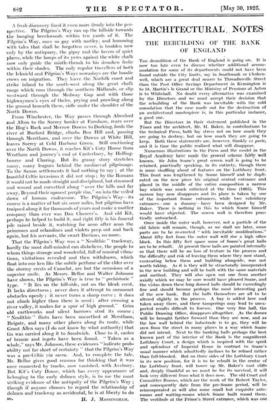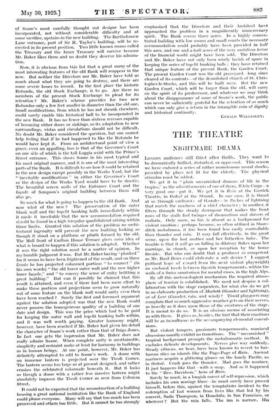ARCHITECTURAL, NOTES
THE REBUILDING OF THE BANK OF ENGLAND
TILE demolition of the Bank of England is going on. It is now too late even to discuss whether additional accom- modation for some of its departments could not have been found outside the City limits, say in Southwark or Clerken- well, which are a great deal nearer to Threadneedle Street than the Post Office Savings Department in Kensington is to St. Martin's le Grand or the Ministry of Pensions at Acton is to Whitehall. No doubt every alternative was examined by the Directors, and we must accept their decision that the rebuilding of the Bank was inevitable with the cold consolation that the case made out for the destruction of an architectural masterpiece is, in this particular instance, a good one.
But the Directors in their statement published in the Times and the architect, Mr. H. Baker, in contributions to the technical Press, both lay stress not on how much they are going to destroy, but on how much they are going to keep. Both these statements are, however, frankly ex parte, and it is time the public realized what will disappear.
Numerous illustrations in the Press and the model in the Royal Academy have made the general scheme fairly well known. Sir John Soane's great screen wall is going to be retained, practically speaking, in its entirety, though there is some shuffling about of features on the Lothbury front. This front was lengthened by Soane himself and he dupli- cated on the new piece his original central entrance and placed in the middle of the entire composition a narrow bay which was much criticized at the time (1805). This narrow bay now disappears and its place is taken by one of the important Soane entrances, while two subsidiary entrances—one a dummy--have been designed by Mr. Baker. There is nothing in this to which Soane himself would have objected. The screen wall is therefore prac-; tically untouched.
Once inside the outer wall, however, not a particle of the old fabric will remain, though, as we shall see later, some parts are to be re-erected " with inevitable modifications." About fifty feet from the outer wall will rise a high office block. In this fifty feet space some of Soane's great halls are to be rebuilt. At present these halls are painted internally so that there will be no loss of texture in the process and the difficulty and risk of leaving them where they now stand, excavating below them and building alongside, was not worth taking. As it is they will be structurally incorporated in the new building and will be built with the same materials and method. They will also open out one from another axially which we may be sure would have pleased Soane, and the vistas down these long domed halls should be exceedingly fine and should become perhaps the most interesting part of the . new bank. But the halls themselves are all to be altered slightly in the process. A bay is added here and taken away there, and these tamperings may lead to unex- peCted results difficult to foresee. One very fine hall, the Public Drawing Office, disappears altogether. As the domes will be brought farther forward than they are now, and as the low wall behind the balustrade is to go, they will be seen from the street in many places in a way which Soane did not intend. Next to the banking halls perhaps the best knoirn part of the interior of the Bank is the magnificent Lothbury Court, a design which is inspired with the spirit and splendour of Imperial Rome in contrast to Soane's usual manner which admittedly inclines to be refined rather than full-blooded. But on three sides of the Lothbury Court in its new position, for it is to be rebuilt in the centre of the Lothbury front, will tower up Mr. Baker's vast cliffs and, deeply thankful as we must be for its survival, it will look very different from what it does now. The old Court and Committee Rooms, which are the work of Sir Robert Taylor, and consequently date from the pre-Soane period, will be reincorporated as will also smile small but exquisite • ante- rooms and waiting-rooms which Soane built round them: The vestibule at the Prince's Street entrance, which was one
of Soane's most carefully thought out designs has been incorporated, not without considerable difficulty and at some sacrifice, upstairs in the new building. The Bartholomew Lane entrance, part of Sir R. Taylor's building, will be re- erected in its present position. Two little known rooms called the Treasury and the Inner Treasury will survive because Mr. Baker likes them and no doubt they deserve his admira- tion.
Now, it is obvious from this list that a great many of the most interesting features of the old Bank will reappear in the new. But neither the Directors nor Mr. Baker have told us much about what they are going to destroy, and there are some severe losses to record. In the first place the historic Rotunda, the old Stock Exchange, is to go. Are there no members of the present Stock Exchange to plead for its retention ? Mr. Baker's scheme provides for two new Rotundas only a few feet smaller in diameter than the old one. Small modifications, from which he has not shrunk elsewhere, could surely enable this historical hall to be incorporated in the new Bank. It has no fewer than sixteen recesses capable of becoming either doors or sinkings, so its adaptation to new surroundings, vistas and circulations should not be difficult. No doubt Mr. Baker considered the question, but one cannot help feeling that if he had happened to like the Rotunda he would have kept it. From an architectural point of view a grave, even an appalling, loss is that of the Governor's Court on one side of which is the tall Loggia axial with the Prince's Street entrance. This shows Soane in his most typical and his most original manner, and it is one of the most interesting parts of the Bank. It is difficult to see how it could be retained in the new design except possibly in the Works Yard, but the " inevitable modifications " in either the Governor's Court or the design of the Works Yard would have to be drastic. The beautiful screen walls of the Entrance Court and the facade of Sampson's original building between them will also go.
So much for what is going to happen to the old Bank. And now what of the new ? The preservation of the outer blank wall and the top-lit banking halls immediately within it made it inevitable that the new accommodation required should be found in a high irregular quadrilateral arising within those limits. Granted this solution of the problem no archi- tectural ingenuity will prevent the new building looking as though it stood on a platform or plinth formed by the old. The Mall front of Carlton House Terrace gives some idea of what is bound to happen if this solution is adopted. Whether it was the right solution must be a matter of opinion. In my humble judgment it was. But Mr. Baker having " planked" for it seems to have been frightened of the result, and on three fronts he has projected columned porticos " to connect " (in his own words) " the old lower outer wall and the new higher inner façade," and " to convey the sense of unity befitting a great building." But can it possibly be claimed that this result is attained, and even if there had been more effort to make these porticos and projections seem to grow naturally out of some feature on the blank wall would unity even then have been reached ? Surely the first and foremost argument against the solution adopted was that the new Bank could never possess the homogeneous quality of a building of one date and design. This was the price which had to be paid for keeping the outer wall and top-lit banking halls within,. and it was well worth paying. Greater harmony might, however, have been reached if Mr. Baker had given his detail the character of Soane's work rather than that of Inig,o Jones. In fact one gets the impression that Mr. Baker does not really admire Soane. When complete unity is unattainable, simplicity and restraint make at least for harmony in buildings as in human beings. At one point, however, Mr. Baker has definitely attempted to add to Soanc's work. A dome with an immense lantern is projected over the Tivoli Corner. The lantern seems too large as at present designed, and rather crushes the celebrated colonnade beneath it. But it looks as though a dome with a rather less massive lantern might absolutely improve the Tivoli Corner as seen from Coleman Street.
It could not be expected that the reconstruction of a building housing a great national institution like the Bank of England could please everyone. Many will say that too much has been preserved and others_too little. But it cannot be too strongly
emphasized that the Directors and their Architect have approached the problem in a magnificently unmercenary spirit. The Bank covers three acres. In a highly concen- trated building with low rooms and small courts the necessary accommodation could probably have been provided in half this area, and one and a-half acres of the very umbilicus lerrae of the financial world might have been sold. The Directors and Mr. Baker have not only been wisely lavish of space in keeping the series of top-lit banking halls ; they have retained that unique feature of the present Bank, the Garden Court. The present Garden Court was the old graveyard—long since cleared of its contents—of the demolished church of St. Chris- topher-le-Stocks, and this will be built over. But the new Garden Court, which will be larger than the old, will carry on the spirit of its predecessor, and whatever we may think about the disappearance of some of Soane's work, the public can never be sufficiently grateful for the retention of so much which can only give a return in the intangible coin of dignity and historical continuity.
GERALD WELLESLEY.











































 Previous page
Previous page